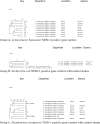Genetic relatedness in carbapenem-resistant isolates from clinical specimens in Ghana using ERIC-PCR technique
- PMID: 31513633
- PMCID: PMC6742460
- DOI: 10.1371/journal.pone.0222168
Genetic relatedness in carbapenem-resistant isolates from clinical specimens in Ghana using ERIC-PCR technique
Abstract
Aim: Enterobacterial repetitive intergenic consensus (ERIC) sequence analysis is a powerful tool for epidemiological analysis of bacterial species. This study aimed to determine the genetic relatedness or variability in carbapenem-resistant isolates by species using this technique.
Methods: A total of 111 non-duplicated carbapenem-resistant (CR) Gram-negative bacilli isolates from a three-year collection period (2012-2014) were investigated by enterobacterial repetitive intergenic consensus-polymerase chain reaction (ERIC-PCR) in four selected hospital laboratories in Ghana. The isolates were also screened for carbapenemase and extended spectrum β-lactamase genes by PCR.
Results: A proportion of 23.4% (26/111) of the genomic DNA extracts were carriers of PCR-positive carbapenemase genes, including 14.4% blaNDM-1, 7.2% blaVIM-1 and 1.8% blaOXA-48. The highest prevalence of carbapenemase genes was from non-fermenters, Acinetobacter baumannii and Pseudomonas aeruginosa. For the ESBL genes tested, 96.4% (107/111) of the CR isolates co-harboured both TEM-1 and SHV-1 genes. The ERIC-PCR gel analysis exhibited 1 to 8 bands ranging from 50 to 800 bp. Band patterns of 93 complex dissimilarities were visually distinguished from the 111 CR isolates studied, while the remaining 18 showed band similarities in pairs.
Conclusion: Overall, ERIC-PCR fingerprints have shown a high level of diversity among the species of Gram-negative bacterial pathogens and specimen collection sites in this study. ERIC-PCR optimisation assays may serve as a suitable genotyping tool for the assessment of genetic diversity or close relatedness of isolates that are found in clinical settings.
Conflict of interest statement
The authors have declared that no competing interests exist.
Figures


References
-
- Londero A, Costa M, Sucari A, Leotta G. Comparison of three molecular subtyping techniques for Listeria monocytogenes. Rev Argent Microbiol. 2019. pii: S0325-7541(19)30004-5. - PubMed
-
- Guimarães Ade S, Dorneles EMS, Andrade GI, Lage AP, Miyoshi A, Azevedo V, et al. Molecular characterization of Corynebacterium pseudotuberculosis isolates using ERIC-PCR. Vet Microbiol. 2011; 153(3–4):99–306. - PubMed
Publication types
MeSH terms
Substances
LinkOut - more resources
Full Text Sources
Medical
Miscellaneous

